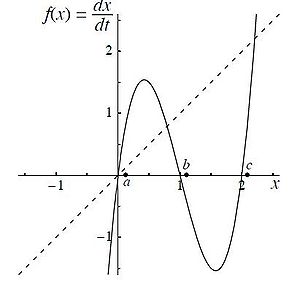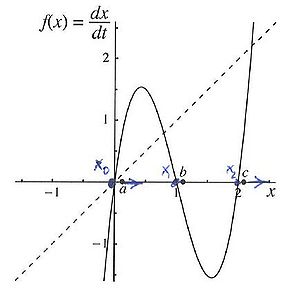Science:Math Exam Resources/Courses/MATH103/April 2013/Question 05 (b)
{{#incat:MER QGQ flag|{{#incat:MER QGH flag|{{#incat:MER QGS flag|}}}}}}
• Q1 (a) • Q1 (b) • Q1 (c) • Q1 (d) • Q1 (e) • Q1 (f) • Q2 (a) • Q2 (b) • Q2 (c) • Q2 (d) • Q3 (a) • Q3 (b) i • Q3 (b) ii • Q4 (a) • Q4 (b) • Q5 (a) • Q5 (b) • Q6 (a) • Q6 (b) • Q6 (c) • Q7 (a) • Q7 (b) • Q7 (c) • Q7 (d) • Q7 (e) • Q8 (a) • Q8 (b) • Q8 (c) • Q9 • Q10 •
Question 05 (b) |
|---|
|
Consider the differential equation . Calculate the steady states (equilibria) and mark them in the sketch below. Find for for the initial points labeled a,b and c (see sketch). |
|
Make sure you understand the problem fully: What is the question asking you to do? Are there specific conditions or constraints that you should take note of? How will you know if your answer is correct from your work only? Can you rephrase the question in your own words in a way that makes sense to you? |
|
If you are stuck, check the hints below. Read the first one and consider it for a while. Does it give you a new idea on how to approach the problem? If so, try it! If after a while you are still stuck, go for the next hint. |
Hint 1 |
|---|
|
Steady states are found in this case by solving for the values of x when the derivative is 0. |
Hint 2 |
|---|
|
At points a,b and c to see what happens as time approaches infinity, you need to know whether the derivative is positive (hence the function is increasing) or negative (hence the function is decreasing). |
|
Checking a solution serves two purposes: helping you if, after having used all the hints, you still are stuck on the problem; or if you have solved the problem and would like to check your work.
|
Solution |
|---|
|
Setting the derivative to 0 and solving gives
and thus, the steady states are . At the point a, the derivative is positive and so the function is increasing and thus approaches the steady state 1 (the first steady states bigger than a). At b, the dervative is negative hence the function is negative and thus approaches the steady state 1. At c, the derivative is positive and so the function is increasing and as t approaches infinity, the function approaches infinity. |
{{#incat:MER CT flag||
}}








